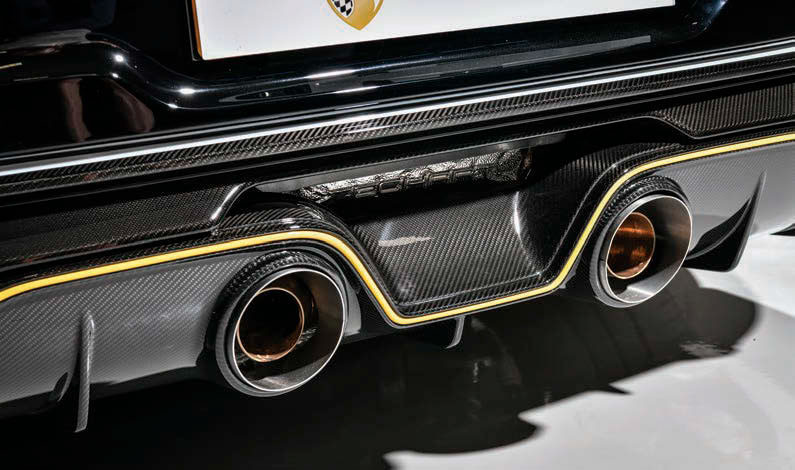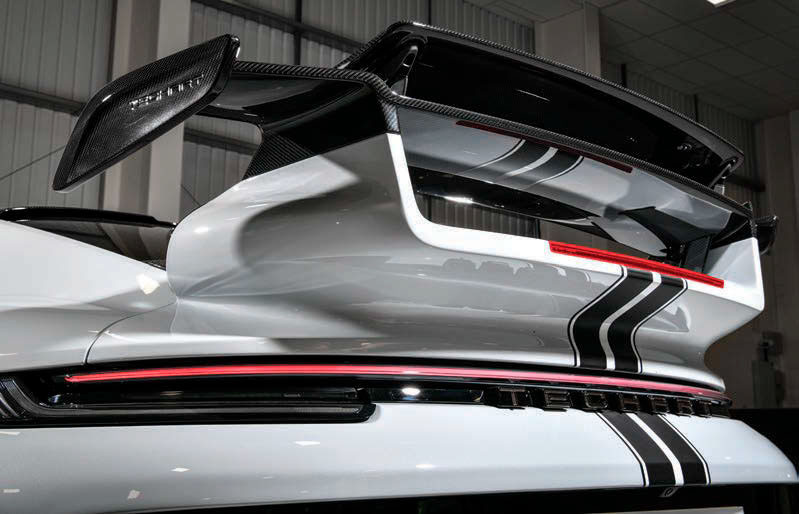TechArt’s new 789bhp 2023 Porsche 911 Turbo S 992 based GTstreet R
Limited to just eighty-seven units, TechArt’s new 911 GTstreet R pays tribute to twenty years of a celebrated tuning programme which kicked off with the 996 Turbo two decades ago...
Words Dan Furr
Photography Chris Wallbank
NEW TECHART 911 GT-STREET R 789BHP 992 TURBO S UPGRADE PACKAGE
PERFORMANCE POWERHOUSE
ART ATTACK The new TechArt 992 GTstreet R.

With its hulk-like hue, more than 700bhp and lashings of lightweight weave, TechArt’s 991 GTstreet R caused a sensation in early 2017. A Clubsport-inspired interior featuring a colour-coded roll bar, six-point safety harnesses and bespoke upholstery formed from soft leather and Alcantara announced the model’s status as a weapon capable of putting in super-quick lap times whilst keeping the driver in the lap of luxury. Power, comfort and aggressive style were offered in abundance, yet the Leonberg-based Porsche tuner was already planning to develop the GTstreet R far beyond what we were presented with at the time of the 991 version’s release into the wild.
INJECT EXCITEMENT INTO THE JOURNEY AT THE FLICK OF THE STEERING WHEEL’S DRIVING MODE ROTARY DIAL

We paid a visit to TechArt and published our findings in the July issue of 911 & Porsche World, but in case you’re new to the Porsche scene, it’s worth us recapping what TechArt is all about. Founded in Fellbach, Germany, in 1987 by a small team keen to provide owners of premium marque sports cars with custom leatherwork, the company soon narrowed its attention to exclusively cater for Porsches. It also extended its portfolio of products and services to include all aspects of vehicle styling. The launch of a custom body kit for the 928 signalled the direction TechArt was heading in, but after the decision was made to build completely new TechArt vehicles based on unmarked Porsche chassis (cars assembled using TechArt’s own parts and materials, and carrying TechArt-specific vehicle identification numbers, achievable after the German government officially recognised the firm as a manufacturer), the arrival of the bespoke 993 CT3 established the brand as one of the world’s leading Porsche specialists.

AN ACCENT OF YELLOW CONTRIBUTES TO AN AESTHETIC MIRRORING ONE OF TECHART’S FACTORY DEMONSTRATORS
Following launch of the 986 Boxster, a new generation of marque enthusiasts became switched on to the idea of Porsche personalisation. TechArt — by now occupying premises in Leonberg — released a hugely successful line of power and styling upgrades for the mid-engined drop-top accordingly. Even so, the company’s now famous GTstreet programme wasn’t launched until the turn of the century. “The 996 Turbo changed everything,” says TechArt boss, Tobias Beyer. “We looked at what Porsche had produced and immediately realised there was an opportunity to further develop it with more track-oriented aero, making the Turbo a more aggressive and more focused driver’s car, but without sacrificing comfort equipment, such as climate control.”

Despite TechArt’s work on Porsche body styling in years previous, the Turbo-based GTstreet was the realisation of the company’s first truly functional aerodynamic package. It proved to be a big hit, giving owners the perfect blend of optimised performance for trackdays and superior comfort for daily driving. The floodgates opened thereafter — among the different 996 offerings produced by TechArt was the GTstreet S package for the GT2, setting a strong foundation for what was to follow. “We’ve produced a GTstreet version of every 911 since the 996,” Tobias tells us. “The 997 saw us develop the concept further with the GTstreet R, featuring an even more aggressive aero package, complete with Gurney flaps, small wings and lots of carbon-fibre.” The 997 GTstreet RS (based, as the name suggests, on the 997 GT2 RS) really shook things up — in May 2008, a GTstreet RS driven by Porsche Supercup stalwart, Jörg Hardt, ran the fastest time at Hockenheim’s annual Tuner Grand Prix. The event record remained unbroken for many years. A few months after Hardt’s Hockenheim triumph, the GTstreet RS completed a record-breaking lap of the Sachsenring. German magazine, Auto Bild, confirms no other Porsche was faster at the Hohenstein-Ernstthal circuit until 2015.

Since 2018, the company’s attitude toward product development has changed. “We appreciate Porsche owners enjoy design language from many different aspects of life,” Tobias tells us. “For this reason, we seek to incorporate influence from beyond the automotive sphere into our work. Aesthetically, our products are arguably more pronounced as a consequence of this approach, but we never forget the lines of the 911. In every sense, TechArt products are a perfect fit for a Porsche.”
All this leads us to the new 911 GTstreet R, pictured on these pages. From every angle, it’s more exaggerated than any current GT product you’ll find rolling off Porsche’s production lines, but don’t dismiss TechArt’s offering as simply an exercising in popping eyeballs — there may be a 992 Turbo S lurking in there somewhere, but the changes Tobias and his team have applied are far more than skin deep. Moreover, the new GTstreet R is something of a love letter to the company’s landmark legacy models.

“The rear wing is a tribute to the CT3,” Tobias smiles, referencing the carbon-Kevlar-clad monster launched in 1996. Equipped with a supercharger, the 993-based model produced 426bhp from a highly modified air-cooled flat-six sitting beneath a massive bespoke rear wing topped by an ‘ironing board’ with an adjustable angle of attack. Sure enough, there’s undeniable similarity with the appendage at the rear of the new GTstreet R, though the technology has come a long way since the heady days of the mid-1990s — when the right driving conditions are met, or when the GTstreet R’s driving mode is altered, the car’s fully carbon-fibre rear wing sprouts another level of aero awesomeness as yet another spoiler makes itself known. Raised electronically (active aero, folks), it works alongside the front splitter, GT3-esque nostrilnosed frunk, wheel arch extensions, side skirts, bumpers and wealth of other parts — all manufactured from the highest quality carbon-fibre, natch — to generate four times more downforce than the Turbo S on which the new GTstreet R is based, whilst significantly reducing lift at high speed. Put aside thoughts of this being merely a styling exercise designed to shock your wallet into submission — the 992 GTstreet R is very much a case of function before form.
That said, there’s no denying the wow factor associated with the GTstreet R’s power figures. Comprehensively outgunning the discontinued 991 GTstreet R, the 992 model is offered with a bonkers 789bhp (800PS in modern parlance) and 701lb-ft torque, contributing to top speed of 217mph. Even the Stage 1 992 GTstreet R package — which is what we’ve come to inspect in deepest, darkest Wales — is chucking out close to 700bhp, a full sixty ponies up on what the 992 Turbo S offers in standard trim. While the ‘full fat’ version makes use of upgraded snail-shaped bhp boosters and other supporting hardware, the Stage 1 variant keeps the OEM turbos and introduces a piggyback ECU to proceedings, the driver inviting it to inject excitement into the journey at the flick of the steering wheel’s driving mode rotary dial.
The design of the car’s front end is something Tobias is especially proud of. “Though we’re creating precision parts from the very latest materials, we very much wanted to pay tribute to the GTstreet programme as a whole, which started with the launch of the 996 Turbo twenty years ago.” The result of countless hours testing in a wind tunnel, every aspect of the bumper and its intakes have been shaped to promote optimised airflow, so much so the angle of the radiators behind have been altered to ensure air passes up through the cutouts in the frunk — thereby increasing downforce — rather than being channelled downward.
THE LOWDOWN
Further enhancing handling, TechArt is offering the new GTstreet R with a choice of suspension upgrades, dropping the ride height by twenty-five millimetres and coming with the option of adjustable coilovers. A third, more hardcore suspension option will be available next year with the release of the GTstreet R Clubsport, born from TechArt’s desire to move its products further into the motorsport arena.
A completely new stainless steel exhaust is in place. “We could have gone down the route of fabricating a system out of titanium, but we’re not oblivious to the fact titanium exhausts can crack under extremes of temperature in high-output applications being put through their paces on track days. Instead, we designed a compact exhaust saving weight, but promoting greater airflow,” Tobias muses. He’s also not convinced by the appointment of sports catalysts. “We’ve made a new muffler, but kept the 992’s original cats. In my experience, the lifecycle of sports catalysts is low, maybe between twenty and thirty kilometres when driven hard. Far better to stick with the original components,” he says.
In contrast, the TechArt team has gone to town on the wheels. Constructed from forged aluminium, they feature fantastic dish at the rear, though this is barely perceptible unless you’re looking at the cloverleaf design from a specific angle — despite what the new GTstreet R’s rear wing might suggest, the devil really is in the detail. Reverse-drilled around the hub, the carefully sculpted lightweight multi-spokes (measuring twenty inches at the front, twenty-one at the rear and wrapped in 265/35 and 325/30 Michelin Pilot Sport 2 black circles respectively) will be joined by an even lighter option when the GTstreet R Clubsport package arrives next year.
Optional carbon-fibre aerodiscs are available now, though. We can’t see them being much use on the road, and there’s every chance they’ll inhibit brake cooling at the track, but they don’t half look good. Peeking out from behind them are the signature yellow calipers of the 992 Turbo S’s standard Porsche Ceramic Composite Brakes (PCCB), which Tobias reasons are more than capable of bringing the GTstreet R to a swift halt, irrespective of the selected power package.
As mentioned earlier, while TechArt seeks to enhance the performance of Porsche sports cars, it does so without compromising on luxury equipment. If seeking improved pace alone, the obvious solution would be to strip the base 911 of all creature comforts, but the GTstreet R adds opulence by way of increased coverings of Alcantara and softer leather. There’s a brilliantly redesigned steering wheel, plus the option of “heritage fabrics” fashioned less like Pasha and more like a chequered flag. We’re not sold on this one, preferring the OEM-plus look of the cabin of the white wonder we’ve come to play with in Wales. Each to their own and all that.
This particular steroid-fed Turbo S is 992 GTstreet R number twenty of a strictly limited eighty-seven units. It says so on the dash-mounted identification plaque and door entry kick plates, so it must be true. Well, kind of. Confusingly, GTstreet R conversions aren’t numbered sequentially. Nevertheless, we’re reliably informed all but a dozen spots on the build run have been reserved, the outstanding number a consequence of Porsche being unable to supply new 911 Turbo Esses as quickly as TechArt customers demand them. Ironically, this well documented problem of supply and demand for new Porsche products is the very reason GTstreet R number twenty was built.
“Our customer wanted a new 911 from the 992 GT line-up, but didn’t want to wait as long as the manufacturer was telling him was necessary,” says Phil Hindley, founder of Tech 9 Motorsport, the Liverpool-based Porsche sales, repair and tuning specialist serving as an official TechArt outpost for as long as the GTstreet programme has existed. “Instead, he supplied us with a 992 Turbo S and placed an order for a Stage 1 GTstreet R conversion, which was completed in August this year following an eight-week build.”
Carrara White paintwork is the perfect contrast to the oodles of moody carbon-fibre, while an accent of yellow contributes to an aesthetic mirroring one of TechArt’s factory demonstrators. In truth, you could have TechArt or Tech 9 Motorsport finish your GTstreet R in whatever colour you like and with whichever elements of interior trim or additional body decoration take your fancy. Red wheels, a yellow body and green stitching? Go for it. In this respect, one of eighty-seven (a number chosen as a nod to the year TechArt was established) becomes one of one within the total run of cars. There’s even a Gulf-liveried 992 GTstreet R currently in the works, plus we’ve seen pictures of a comparatively understated example finished in British Racing Green. For our money, however, Carrara White trumps even Racing Yellow, the colour of the GTstreet R seen in TechArt’s recently published press photos.
We know what the benefits are, but what’s involved in a 992 GTstreet R conversion? “Imagine the most complex Lego Technic kit possible,” Phil laughs. “The GTstreet R package is hugely comprehensive, which makes shipping overseas a massive logistical undertaking, especially when you consider TechArt has agents in countries all over the world,” he adds, acknowledging Leonberg to Liverpool is a relatively straightforward route when compared to shipping GTstreet R conversion kits to cities in North America, Asia, Australia and the Middle East.
“As Porsche cars have become technically more complex, TechArt products have become equally advanced,” he continues. “You certainly realise how simple a 996 Turbo is when you’re dismantling a 992 Turbo S, which features a high number of modern driver aids, such as surround parking cameras, which have to be accommodated by the TechArt design team.” There’s also individually optioned 911 equipment to consider, meaning one 992 Turbo S can be different to the next. This is an aspect of product design Tobias confirms is TechArt’s biggest challenge, but one Phil recognises has been met with the highest standards of care and attention. “The way GTstreet R components fit is nothing short of amazing. I’ve seen first-hand the evolution of TechArt products during the course of the past two decades and this 992 Turbo S conversion raises the bar well beyond anything the company has produced in the past. Moreover, to have rolled this out for competent installers all over the world is very impressive.”
SHIPPING FORECAST
This isn’t the first TechArt conversion the Tech 9 Motorsport team has carried out for the owner of the GTstreet R seen here. “He’s been a TechArt devotee for the past decade,” Phil tells us, before explaining the process of conversion. “Following conversations with our customer, we place an order, the requested kit is prepared for despatch in Leonberg, a custom-built crate is then loaded onto a TechArt truck, it arrives in Liverpool and we begin pre-fitting all the parts to the host Porsche. When satisfied everything is exactly as it should be, we can then carry out final fitting before moving on to the exciting stage of road testing.”
Make no mistake, the 992 Turbo S is a fantastically capable car in standard trim. Even the 572bhp non-S 992 Turbo is extraordinary, registering a sprint to 62mph from rest in a tenth of a second off the Turbo S’s bullet-out-of-a-gun launch of 2.7 seconds. The Turbo S, armed with 590lb-ft torque, adds an extra 6mph, romping on to 205mph. The Turbo can manage ‘only’ 199mph. As we’ve said in previous issues of 911 & Porsche World, a tenth here and a 200mph-plus there doesn’t cut it when evaluating whether to spend the additional £21,450 required to elevate a Turbo to a Turbo S. The new GTstreet R, on the other hand, makes a compelling case for upping the ante, even in Stage 1 trim, let alone the outrageous near 800bhp of the no holds barred version. And then there’s the Clubsport, which will be limited to just nineteen examples.
Unfiltered, the exhaust makes the kind of sound you’d expect from a 911 clothed in carbon and Alcantara. It’s loud, but not in an obtrusive way. You want it to be loud. Of course, out here on the public road, it’s difficult to take full advantage of the performance on offer, meaning while the GTstreet R is amazingly urgent, we’re certainly not tapping into the full potential of the package, though when traffic is clear, pedal to the metal is a thrilling experience, regardless of where you are in the rev range. The jolt forward is brutal and can catch you unaware, as though you’ve accidentally leaned on the hyperdrive button in the Millennium Falcon. While we won’t pretend to be aerodynamicists, this car feels astonishingly planted, suggesting the suspension and aero package is working wonders, though the standard 992 Turbo S is hardly lacking in this department and those sticky Michelins are clearly doing their thing. A track is, of course, where the full force of what TechArt has achieved will come into its own, more so if you’ve got a stampede of eight hundred horses at your disposal.
Nevertheless, it’s obvious the GTstreet R is staggeringly quick and the handling revelatory. Traction is ferocious, proving just how much time and effort has gone into affording GTstreet R owners the opportunity to harness the power available, Stage 1 or otherwise — it’s all too easy for tuners to develop a performance package with high output, but to neglect the chassis, making dizzying numbers printed in promotional materials good for nothing. The amount of time Tobias and his team have spent optimising the suspension and racking up bills in wind tunnels has certainly paid off.
Throw the GTstreet R into twisties and you find the steering is super-communicative and boasts an immediacy rivalling anything the new GT3 can do. Incidentally, TechArt already has an upgrade package for the 992 GT3 in both Touring and stripped-down guise, as well as offerings for the 992 Carrera, Targa and GTS models. There’s a selection of Turbo and Turbo S offerings too, including individual options for wheels and “intelligent power”. The GTstreet R is where it’s at, though.
“We have every department necessary for vehicle production, whether it’s engineering for chassis development, wheels, exhausts, body styling, aerodynamics, engine tuning, parts production or testing,” Tobias confirms. “Naturally, we also have offices for marketing, domestic sales and export functions, plus our leatherwork division, paint shop and carbon-fibre parts manufacturing branch.” Dyno, emissions and impact testing is also carried out at the company’s base in Leonberg, while wind tunnel testing and TUV approval is conducted at off-site locations in and around Stuttgart. We mention this in case you previously thought of TechArt as little more than an automotive fashion brand. This assessment couldn’t be further from the truth — think of TechArt like a mini-Porsche, carrying out its research, development, design and manufacturing operations in-house, working to the very same standards and utilising the same methodology, just on a smaller scale. Suddenly, TechArt’s status as a vehicle manufacturer makes much more sense.
The cost of a GTstreet R upgrade for the 992 Turbo S starts at around €73,000, which is no small sum, but consider this: the market has such faith in the quality of TechArt products, 911s carrying the company’s conversion kits tend to hold their value and have no trouble finding new homes when commissioning purchasers have had their fun. Given TechArt-tuned Porsches look, handle and propel themselves as good as this, we’re not surprised. Give the Tech 9 Motorsport team a call and reserve your GTstreet R kit before they’re all gone.
Above and below The extra poke and insane levels of traction are brutal, but need to be explored fully at a track.
Above and below Interior can be optioned with TechArt’s chequerboard fabrics, though the Tech 9 build keeps the more restrained standard Turbo S leather.
Below New exhaust is a stainless system, rather than titanium.
Above The standard of fit and finish of TechArt products is second to none.
Below CT3-inspired massive rear wing sprouts an additional spoiler for extra downforce, contributing to twenty-five percent more load over the rear than found with the standard Turbo S.
Above Stage 1 package adds sixty horses to the Turbo S, while the flagship GTstreet R punches toward 800bhp.


